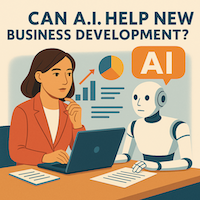As advertising, creative and PR agencies ramp up their efforts to secure new clients, many are weighing up AI in new business development. It promises efficiency, speed, and cost-saving benefits. But can it truly replace the nuance and personalisation required in the world of marketing communications new business?
Let’s explore the main advantages and potential pitfalls of using AI in lead generation for agencies.
1. Smarter Prospecting or Misguided Targeting?
AI can rapidly scan, segment and score leads based on behavioural signals, digital footprints and predictive data. For creative agency business development, this means sales teams can focus their efforts on those with a high likelihood of converting.
However, it’s not foolproof. If the input data is off, AI can easily misidentify potential clients – something we’ve experienced first-hand. Our new business agency has been targeted multiple times by AI email campaigns that confuse us with a famous PR agency. Besides being irrelevant, it damages the sender’s reputation – particularly when they’re promoting the intelligence of their tech.
2. Relevance Is Not the Same as Relationship
AI can personalise communications using browsing behaviour and data insights, theoretically increasing engagement. But in practice, agency prospects can often spot a templated email a mile off. Authenticity matters in PR new business development, and the best-performing campaigns often involve nuance, warmth and improvisation – traits AI still struggles to replicate.
3. Advanced Analytics That Depend on Flawless Data
AI tools are powerful when it comes to crunching data and identifying patterns. For digital agency new business teams, this means sharper targeting and better-informed decision-making.
That said, it all hinges on clean, current and accurate data. Outdated or incorrect databases can lead to wasted effort, missed opportunities and poor-quality engagement. Human-led campaigns can adapt in real-time – a quick phone call often reveals more about a prospect than an algorithm ever could.
4. Efficiency at Scale vs. the Need for Depth
AI can save time and reduce manual tasks such as lead qualification, email follow-ups and list segmentation – especially useful in marketing agency new business efforts, where outreach volume can be high.
But when conversations become more complex, or prospects raise objections, AI falls short. Chatbots and automated responses are no substitute for a seasoned business development lead who can tailor a pitch, read a room or answer difficult questions on the fly.
5. The Problem with “One-Size-Fits-All” Outreach
As more agencies adopt similar AI tools, outreach risks becoming formulaic. Prospects are flooded with identical messages and subject lines, reducing cut-through. This lead saturation means that true differentiation – especially for PR agencies or boutique creative shops – becomes more difficult.
Real human contact allows for a pivot in tone or messaging that algorithms can’t yet manage effectively.
6. Always-On, But Not Always Helpful
AI tools don’t sleep, meaning inbound leads can be captured and responded to 24/7. This is beneficial for global campaigns or when operating across time zones. But for B2B agency new business, round-the-clock availability only gets you so far – prospects still expect thoughtful replies, not robotic autoresponders.
7. Integration Challenges Can Undermine Efficiency
A major plus of AI in agency CRM systems is the potential for seamless data syncing and unified customer views. If executed well, it gives new business teams clearer visibility into lead journeys.
However, integration isn’t always straightforward. Many agencies find that AI platforms don’t always play nicely with legacy CRM setups, leading to duplication, confusion, and data silos.
8. Legal Risks and Data Compliance
Agencies using AI for lead generation must stay on the right side of data protection laws like GDPR. Many AI systems operate globally and may not account for regional compliance needs, meaning the responsibility lies with your internal team to stay lawful and transparent.
9. Cost Benefits vs. Long-Term Value
The cost-saving potential of AI in marketing agency business development is often a key attraction. Automating tasks reduces headcount needs and boosts productivity.
But what’s saved in cash could be lost in connection. A well-timed phone call, a tailored proposal or a face-to-face meeting can seal a deal in a way that automated processes rarely can.
10. Why AI Should Be an Assistant, Not a Replacement
Ultimately, people still buy from people. AI can play a valuable supporting role in advertising agency lead generation – helping with timing, volume and targeting. But creative and PR new business strategies still demand a personal approach. The ideal setup blends smart automation with human intuition, insight and flexibility.
Final Thoughts
AI is here to stay – and for new business professionals in agencies, it offers exciting opportunities. But the best-performing campaigns will continue to combine data-driven tools with emotional intelligence, sector knowledge and interpersonal skill.
In other words: use AI to accelerate, but keep the human in the loop to connect.

